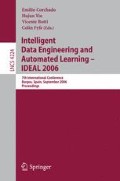Abstract
Context recognition in indoor and outdoor surroundings is an important area of research for the development of autonomous systems. This work describes an approach to the classification of audio signals found in both indoor and outdoor environments. Several audio features are extracted from raw signals. We analyze the relevance and importance of these features and use that information to design a multi-stage classifier architecture. Our results show that the multi-stage classification scheme is superior than a single stage classifier and it generates an 80% success rate on a 7 class problem.
Access this chapter
Tax calculation will be finalised at checkout
Purchases are for personal use only
Preview
Unable to display preview. Download preview PDF.
References
Boersma, P.: Accurate Short-Term Analysis of the Fundamental Frequency and the Harmonics-to-Noise Ratio of a Sampled Sound. In: Institute of Phonetic Sciences, University of Amsterdam, Proceedings, vol. 17 (1993)
Choi, S., Cichocki, A., Park, H.-M., Lee, S.-Y.: Blind Source Separation and Independent Component Analysis: A Review. Neural Information Processing – Letters and Review 6(1), 1–57 (2005)
Do, M.N.: An Automatic Speaker Recognition System. Audio Visual Communications Laboratory, Swiss Federal Institute of Technology, Lausanne, Switzerland
Gerhard, D.: Audio Signal Classification: History and Current Techniques, Technical report TR-CS 2003-07 (2003)
Hu, Y.H., Hwant, J.-N.: Handbook of Neural Network Signal Processing. CRC Press, Boca Raton
Jain, A., Zongker, A.: Feature selection: evaluation, application, and small sample performance. IEEE Transactions PAMI 19(2), 153–158 (1997)
Kleinschmidt, M.: Methods for capturing spectro-temporal modulations in automatic speech recognition. Acustica united with acta acustica 88(3), 416–422 (2002)
Kobes, R., Kunstatter, G.: Physics 1501 – Modern Technology. Physics Department, University of Winnipeg
Liu, Z., Wang, Y.: Audio Feature Extraction and Analysis for Scene Segmentation and Classification. Journal of VLSI Signal Processing, 61–79 (1998)
Liu, Z., Huang, J., Wang, Y.: Classification of TV Programs Based on Audio Information Using Hidden Markov Model. In: IEEE Workshop on Multimedia Signal Processing (1998)
Logan, B.: Mel Frequency Cepstral Coefficients for Music Modelling, Cambridge Research Laboratory
Lu, L., Zhang, H.-J., Jiang, H.: Content Analysis for Audio Classification and Segmentation. IEEE Transactions on Speech and Audio Processing 10, 504–516 (2002)
Mallat, S.: A wavelet tour of signal processing. Academic Publishers
Rabiner, L.R., Schafer, R.W.: Digital Processing of Speech Signals. Signal Processing Series. Prentice-Hall, Englewood Cliffs (1978)
Safavian, S.R., Landgrebe, D.A.: A Survey of decision tree classifier methodology. IEEE Trans SMC, 660–674 (1990)
Scheirer, E., Slaney, M.: Construction and Evaluation of a Robust Multifeature Music/Speech Discriminator. Proceedings of IEEE ICASSP 2, 1331–1334 (1997)
Tzanetakis, G., Cook, P.: Audio Information Retrieval (AIR) Tools. Department of Computer Science and Department of Music. Princeton University, Princeton
Tzanetakis, G., Cook, P.: Multifeature Audio Segmentation for Browsing and Annotation. In: Proc. IEEE Workshop on Applications of Signal Processing to Audio and Acoustics, pp. 103–106 (1999)
Viikki, O., Laurila, K.: Cepstral domain segmental feature vector normalization for noise robust speech recognition. Speech Communication 25, 133–147 (1998)
Xu, C., Maddage, N., Shao, X., Cao, F., Tian, O.: Musical Genre Classification using Support Vector Machines. In: IEEE ICASSP (2003)
Yantorno, R.E., Iyer, A.N., Shah, J.K., Smolenski, B.Y.: Usable Speech Detection Using a Context Dependent Gaussian Mixture Model Classifier. In: IEEE International Symposium on Circuits and Systems (2004)
Author information
Authors and Affiliations
Editor information
Editors and Affiliations
Rights and permissions
Copyright information
© 2006 Springer-Verlag Berlin Heidelberg
About this paper
Cite this paper
Lopes, J., Lin, C., Singh, S. (2006). Multi-stage Classification for Audio Based Activity Recognition. In: Corchado, E., Yin, H., Botti, V., Fyfe, C. (eds) Intelligent Data Engineering and Automated Learning – IDEAL 2006. IDEAL 2006. Lecture Notes in Computer Science, vol 4224. Springer, Berlin, Heidelberg. https://doi.org/10.1007/11875581_100
Download citation
DOI: https://doi.org/10.1007/11875581_100
Publisher Name: Springer, Berlin, Heidelberg
Print ISBN: 978-3-540-45485-4
Online ISBN: 978-3-540-45487-8
eBook Packages: Computer ScienceComputer Science (R0)

